les cephalopodes cretaces du bassin coti er de tarfaya
les cephalopodes cretaces du bassin coti er de tarfaya
les cephalopodes cretaces du bassin coti er de tarfaya
Create successful ePaper yourself
Turn your PDF publications into a flip-book with our unique Google optimized e-Paper software.
que chez cette d<strong>er</strong>nière espèce (<strong>du</strong> Cénomanien inférieur)<br />
cette ornementation chênge très vite, ici, elle<br />
p<strong>er</strong>siste jusqu'à l'extrémité <strong>du</strong> tour d'ailleurs encore<br />
cloisonné chez <strong>les</strong> 3 exemplaires examinés.<br />
Il y a aussi beaucoup d'ênalogies avec Pachy<strong>de</strong>smocen!s<br />
coh(saënse ANDERSON <strong>du</strong> même niveau en<br />
Californie, mais dont la section est nettement aplz:tie<br />
(1, p. 96, Pl. V, fig. 128-129), et aussi avec Pachy<strong>de</strong>smocems<br />
dill<strong>er</strong>i ANDERSON (1, p. 97, pl. IV, fig. 116-117)<br />
1921. Beudanticems Beudanti (3RONGNIART) Spath (L.F.)<br />
A Monograph of the Ammonoidca of the Gault. I.<br />
(Pal. Soc. p. 49, Fig. 12 a-c ; Pl. II, Fig. 4 a-d, Bibliographie)<br />
.<br />
Diamètre total ............ .<br />
CÉPHALOPODES CRÉTACÉS DU BASSIN COTIER DE TARFAYA 15<br />
Hauteur <strong>du</strong> d<strong>er</strong>ni<strong>er</strong> tour ............. .<br />
Epaisseur <strong>du</strong> d<strong>er</strong>ni<strong>er</strong> tour<br />
JŒC/).L\TJCHJUS JŒCD.L\Tl BHGT.<br />
Pl. 3, fig. 1, la<br />
Diamètre <strong>de</strong> l'ombilic . . . . . . . . . . . . . . . . . . . . . . . . . . . . . . . . . . . . . . . . . . . . . . . . . . . . . .<br />
Demi-exemplaire présentant toutes <strong>les</strong> caractéristiques<br />
<strong>de</strong> l'espèce : forme, dimensions proportionnel<strong>les</strong>,<br />
section, ornementation (médiocrement cons<strong>er</strong>vée)<br />
et cloison.<br />
Paraît très répan<strong>du</strong> à Tarfaya ou 6 exemplaires,<br />
à'ailleurs tous médiocres, présentent <strong>les</strong> mêmes cm·actères.<br />
10 autres, plus ou moins fragmentaires, déformés<br />
ou écrasés, appartiennent vraisemblablement à<br />
cette espèce.<br />
1921. Desmoc<strong>er</strong>as latidorsatum (MICHELIN) Spath (L.F.) A<br />
Monograph of the Ammonoi<strong>de</strong>a of the Gault, I, (Pal.<br />
Soc. p. 39, Fig. 9 ; Pl. Il, Fig . 2 a-b, Bibliographie).<br />
Diamètre total .......... .<br />
Hauteur <strong>du</strong> d<strong>er</strong>ni<strong>er</strong> tour<br />
J)f:'S.l!OCEN.IS' LI TJDOUSATU.ll .\lien.<br />
Pl. 3, Fig. 2<br />
qui présente une ornementation cie ::::::e style. r:1ai::<br />
avec <strong>de</strong> profon<strong>de</strong>s constrictions.<br />
Gisements : T. 481 - Près <strong>de</strong> la co:e. .-:::: :o.·_; S\\"<br />
<strong>de</strong> Foum Chebeika. T. 483-484 - Oued C!-Je':Jei;:;.. :·:._·e<br />
gauche, Sud <strong>de</strong> Rassi Oum Esbed.<br />
T. 10 - Oued Chebeika Est <strong>de</strong> Rassi Oum EsQec. :;:ec:<br />
NW <strong>de</strong> la Rammada el Gueblia.<br />
Zone à Dipoloc<strong>er</strong>as cristatmn, dans <strong>les</strong> <strong>de</strong>ux ni\·ea·..Lx.<br />
1931. Beudantic<strong>er</strong>as Beudanti (BRGT.) Seitz (0.) Zur Morphologie<br />
d<strong>er</strong> Ammoniten aus <strong>de</strong>m Albien II (Jahrb<br />
Preuss. Lan<strong>de</strong>sanst. Vol. LII, p. 406 ; PL XVII, Fig. 3<br />
a-d) .<br />
0,083<br />
0,043 (0,52)<br />
0,023 (0,28)<br />
0,011 ( 0,13)<br />
D'après L.F. Spath, Beudantic<strong>er</strong>as Beudanti BRGT.<br />
est une espèce commune dans la zone à cristatum<br />
dont elle est l'un <strong>de</strong>s éléments <strong>les</strong> plus caractéristiques.<br />
Gisement : T. 10 - Ot:ed Chebeika, Est <strong>de</strong> Rassi<br />
Oum Esbed, pied NW <strong>de</strong> la Rammada El Gueblia.<br />
Zone à Dipoloc<strong>er</strong>as cristatum, niveau inférieur.<br />
Epaisseur <strong>du</strong> d<strong>er</strong>ni<strong>er</strong> tour ................................................ .<br />
Diamètre <strong>de</strong> l'ombilic . . . . . . . . . . . . . . . .. . . . . . . . . . . . . . . . .. . . . . . . .. . . . . . . .. . . . .<br />
Les dimensions données sont cel<strong>les</strong> <strong>de</strong> l'exemplaire<br />
le mieux cons<strong>er</strong>vé. Cette espèce, qui est très abondante<br />
à Tarfaya, surtout en gros exemplaires (15<br />
exemplaires), n'a pas gran<strong>de</strong> signification stratigraphique,<br />
car elle existe dans tout l'Albien, surtout<br />
moyen et supérieur, et monte même dans le Céno-<br />
1949. Latidorsella latidorsata (MICHELIN) C:.llignon (:\1.)<br />
Rech<strong>er</strong>ches sur <strong>les</strong> Faunes Albiennes <strong>de</strong> ::\Iadagascar.<br />
1. L'Albien d'Ambarimaninga (Ann. Geol. Sen·.<br />
<strong>de</strong>s Mines, T. XVI, p.62. Bibliographie) .<br />
manien inférieur.<br />
Répartition ubiquiste.<br />
0,100<br />
0,047 (0.47)<br />
0,045 (0.45)<br />
0.020 ( 0.20)<br />
Gisement : T. 10 - Voir ci-<strong>de</strong>ssus.<br />
Zone à Dipoloc<strong>er</strong>as cristatum, niyeau inférieur.

















